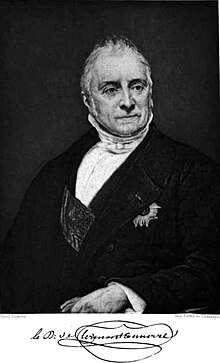You can help expand this article with text translated from the corresponding article in French. Click for important translation instructions.
|
| Aimé-Marie-Gaspard, comte de Clermont-Tonnerre | |
|---|---|
| Born | (1779-11-27)27 November 1779 Paris, Kingdom of France |
| Died | 8 January 1865(1865-01-08) (aged 85) Glisolles, French Empire |
| Nationality | French |
Aimé-Marie-Gaspard, comte de Clermont-Tonnerre (27 November 1779 – 8 January 1865) was a French general and statesman.
Son of Gaspard-Paulin, vicomte de Clermont-Tonnerre and Anne-Marie- Louise Bernard de Boulainvilliers, and grandson of the Marquis de Boulainvilliers, Clermont-Tonnerre lived during the revolution with his grandfather.
Life

He entered the École Polytechnique, before entering the army. He participated in the campaigns in Italy, Germany and Spain and was made adjudant of the King of Naples in 1808, in whose service he stayed afterwards. He married Charlotte de Cauvoisin and in 1814 returned to the French army as a colonel, was Maréchal de Camp and after the second return of the king, was made Peer of France and commander of the cavalry of the guard.
Clermont-Tonnerre sided with the moderate conservative party and was named Minister of the Navy and the Colonies in 1820 by Villèle. In 1823, he became Minister of War and assiduously reorganized the army.
Clermont-Tonnerre sent Hyacinthe de Bougainville around the world from 1824 to 1826 onboard Thétis and Espérance.
In 1827, he organized the Algerian expedition, which was executed in 1830.
After the revolution, he refused to swear allegiance to the new government of Louis-Philippe and retired into private life. In 1852, he lobbied for the first rail line between Paris and Cherbourg-en-Cotentin to pass through the department of Eure. He died on his estate in Glissolles.
The Hawaiian plant genus Clermontia was named in his honor by Charles Gaudichaud-Beaupré.
References
- The Bourbon Restoration - Page 180 by Guillaume de Bertier de Sauvigny
- The French Explorers and the Aboriginal Australians 1772–1839 By Colin L. Dyer p.12
- Camille Rousset, Le marquis de Clermont-Tonnerre (Par. 1885)
| Political offices | ||
|---|---|---|
| Preceded byAnge Hyacinthe Maxence, baron de Damas | Minister of War 4 August 1824 – 4 January 1828 |
Succeeded byLouis Victor de Blacquetot de Caux |
| Ministry of Joseph de Villèle (14 December 1821 to 6 December 1827) | ||
|---|---|---|
| Head of state: King Louis XVIII of France − Charles X of France | ||
| President of the council | Jean-Baptiste de Villèle |  Villèle |
| Finance | ||
| Foreign Affairs | ||
| Interior | ||
| Justice | ||
| Navy and Colonies | ||
| War | ||
| King's Household | ||
| Religious Affairs | ||
| Minister of State | ||
- 1779 births
- 1865 deaths
- Politicians from Paris
- Politicians of the Bourbon Restoration
- Dukes of Clermont-Tonnerre
- French generals
- Grand Officers of the Legion of Honour
- Ministers of marine and the colonies
- Members of the Chamber of Peers of the Bourbon Restoration
- French military personnel of the Napoleonic Wars
- Ministers of war of France